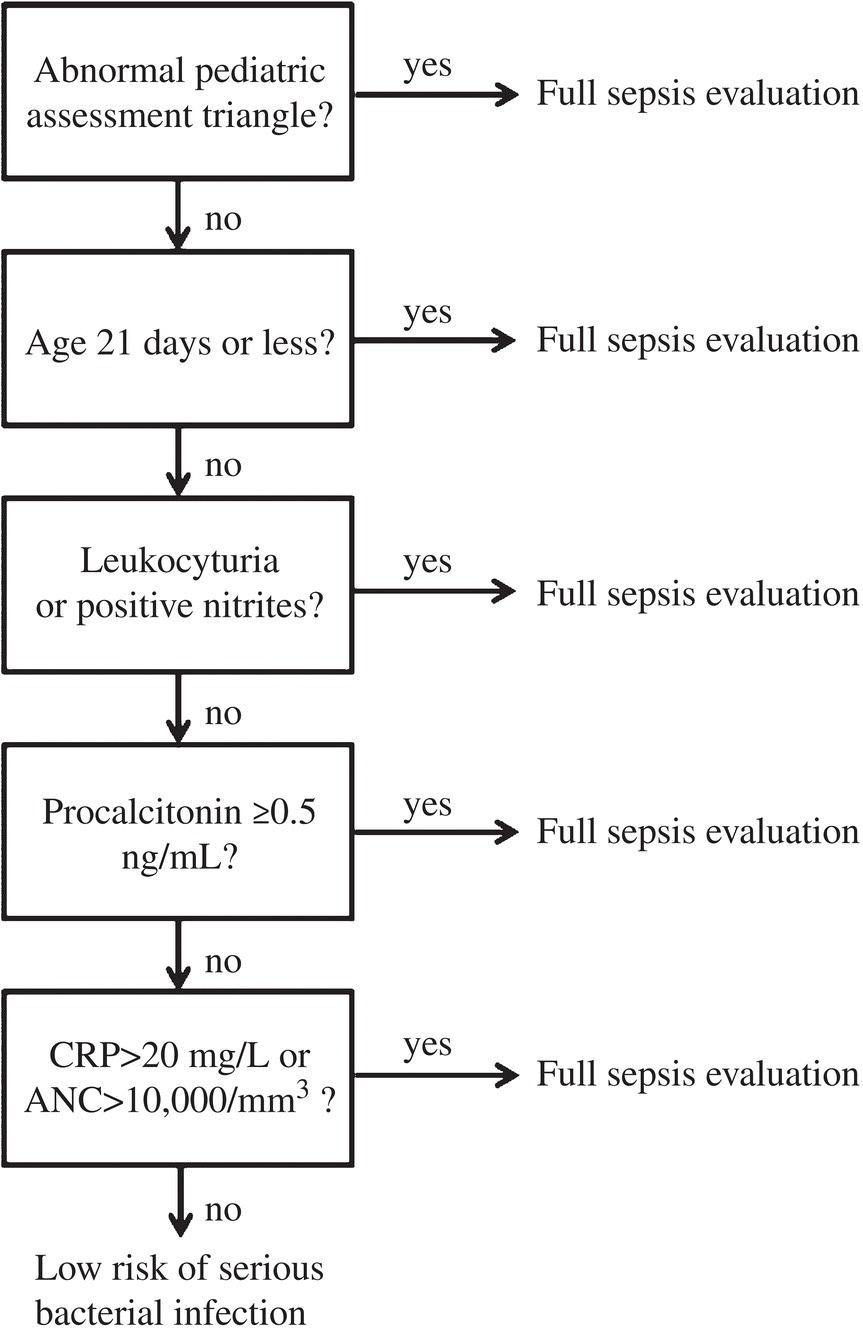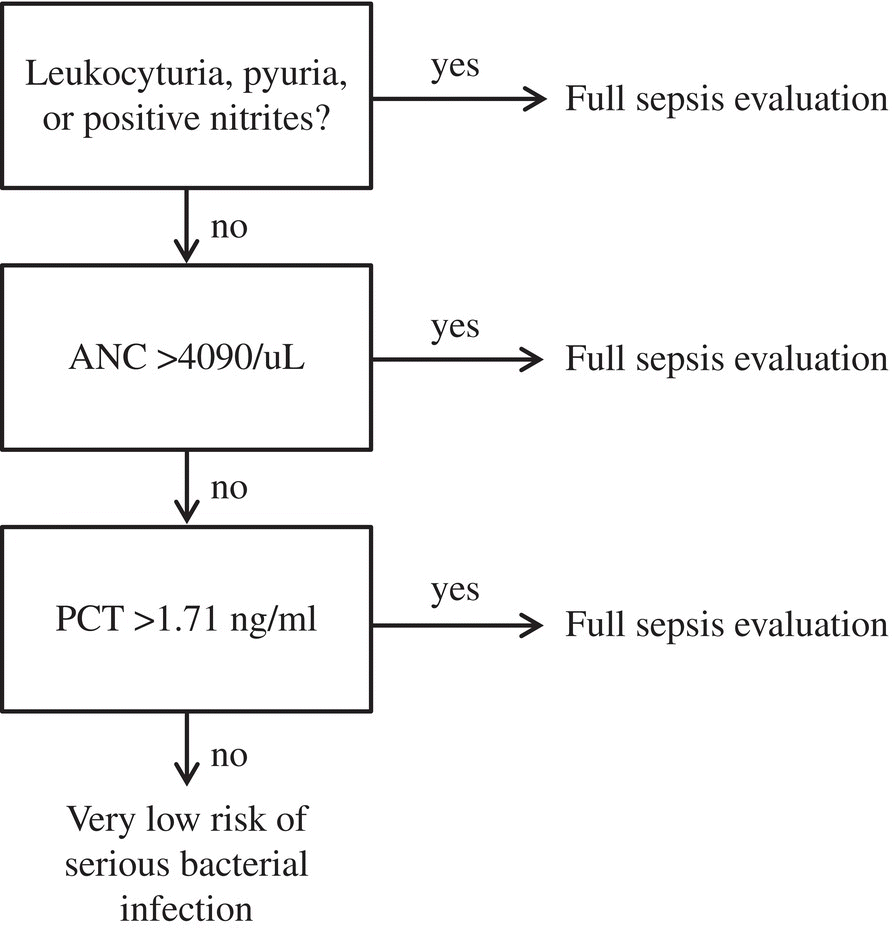Jana L. Anderson and Fernanda Bellolio Department of Emergency Medicine, Mayo Clinic, Rochester, MN, USA There is great variation in the management of febrile infants.1 The current estimates for serious bacterial infections (SBIs) including urinary tract infection (UTI), bacteremia, and meningitis in well‐appearing febrile infants less than 28 days are UTI 10.0%, bacteremia 3.1% (CI 2.3–4.1%), and meningitis 1.3% (CI 0.8–2.0%).2,3 For older infants, 29 to 60 days of age, the rate of SBI is UTI 7.3 to 8.2%, bacteremia 1.1% (CI 0.8–1.6%), and meningitis 0.2% (CI 0.1–0.4%).2,3 The febrile infant evaluation paradigm has shifted given two large multicenter studies, the Step by Step (SbS) and the Pediatric Emergency Care Applied Research Network (PECARN) febrile infant rules.3,4 The American Academy of Pediatrics (AAP) published in 2021 a Clinical Practice Guideline (CPG) combining data from four large datasets (including PECARN), and reported the following aggregated rates of bacteremia: 8 to 21 day old – 4% bacteremia, 22 to 28 day old – 2.9% bacteremia, and 29 to 56 days – 2% bacteremia.5 SbS (Figure 24.1) and the PECARN febrile infant rules (Figure 24.2), both use a sequential approach to febrile infants less than 60–90 days of age to determine if the infant is at increased risk for SBI and therefore a full sepsis evaluation, antibiotics and admission are warranted. The CPG from the AAP recommends the use of inflammatory markers (CRP and procalcitonin [PCT]) in older infant (≥22 days of age) to decide if a lumbar puncture (LP), antibiotics, or admission are necessary.5 Previous rules like Rochester, Philadelphia, and Boston criteria,6,7 were developed before the introduction of polyvalent conjugate pneumococcal and Haemophilus influenzae type B (Hib) vaccines, improved food safety for Listeria monocytogenes, and routine maternal group B strep testing. Figure 24.1 Step‐by‐Step febrile infant protocol. (Data from [4].) Figure 24.2 PECARN febrile infant protocol. (Data from [3].) How do newer clinical decision rules compare to previous ones? Are clinical decision rules useful in ruling out serious bacterial infection in children? SbS, PECARN, and the AAP CPG define fever as a rectal temperature of ≥38.0 °C (100.4 °F) similar to the traditional Rochester and Boston Criteria, and lower than the Philadelphia protocol of 38.2 °C.6,7 Overall, all protocols apply to “well‐appearing” infants; while SbS protocol specifically utilizes the Pediatric Assessment Triangle (PAT) to determine ill appearance, the PECARN protocol utilized the Yale Observation Score (YOS) in the study. The AAP CPG uses the term “well‐appearing” but also recognizes that there are likely three categories: ill, intermediate, and well‐appearing. All the febrile infant literature recommends that appearance alone should not be utilized to determine if a full sepsis evaluation is not needed particularly in the younger infant.8,9 The SbS protocol was developed for infants less than 90 days and then classifies all infants less than 21 days as high risk. The PECARN and the AAP CPG protocols apply to all febrile infants less than 60 days of age. Both SbS and PECARN protocols use a positive urine early in the sequence to classify the infant as high risk for SBI and therefore warrant a full sepsis evaluation. The AAP CPG was developed for the 8‐ to 60‐day‐old infant and emphasizes testing for invasive bacterial infections (IBI, including bacteremia and meningitis) among those 21 days and younger. Previous rules for febrile neonates defined an UTI as >10 WBCs/hpf (white blood counts/high power field) or >10 WBC/μL on enhanced urinalysis to define an abnormal urine.7 With improved urinalysis technique, practice has evolved to using the presence of leukocyte esterase or nitrites, and/or >5 WBC/hpf to define an abnormal urinalysis.10 AAP CPG defines the urinalysis as “positive” as the presence of any leukocyte esterase on dipstick, >5 WBC/hpf in centrifuged urine, or >10 WBCs/mm3 in uncentrifuged urine on microscopic urinalysis. Both SbS and the AAP CPG utilize PCT at different thresholds than PECARN. PECARN used recursive partitioning to determine a cut‐off level, which was determined to be a PCT >1.71 ng/mL. SbS and the AAP CPG used a lower threshold at ≥0.5 ng/mL. To utilize PCT, fever should be present for at least 2 hours and preferably 4 to 6 hours to reflect the body’s inflammatory response. Both the SbS and PECARN protocols utilize the ANC (absolute neutrophil count) to replace bands, neutrophils, and total WBC counts of the traditional protocols.6,7,11 The threshold determined by the PECARN febrile infant rules is ANC > 4090/μL to define high risk. The SbS protocol utilizes an ANC > 10,000/mm3 (one microliter is equivalent to one cubic millimeter) to define intermediate risk. In addition, the SbS protocol uses either elevated ANC or CRP >20 mg/L to define intermediate risk. The sequence of the SbS algorithm to detect infants at increased risk for IBI defined as bacteremia or meningitis is (i) abnormal PAT (the three areas of assessment are: appearance, work of breathing, and circulation to skin); (ii) age ≤ 21 days; (iii) leukocyturia (>5 WBC/HPF) or positive leukocyte esterase or nitrites; and (iv) PCT ≥ 0.5 ng/mL. If any of these first four parameters are positive, the infant is classified as high‐risk, with an incidence of IBI of 8.1%, and a full sepsis evaluation is recommended. The fifth and final step of the SbS protocol is CRP >20 mg/L or ANC > 10,000/mm3
Chapter 24
Serious Bacterial Infections in Children Aged 0 to 60/90 Days
Background


Clinical question

Full access? Get Clinical Tree






